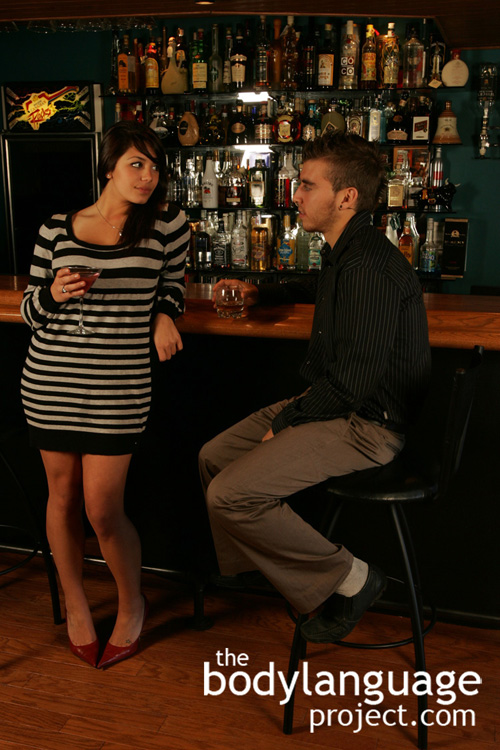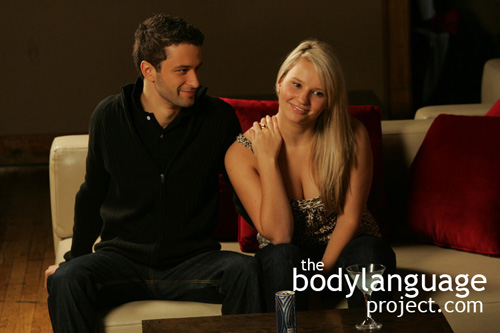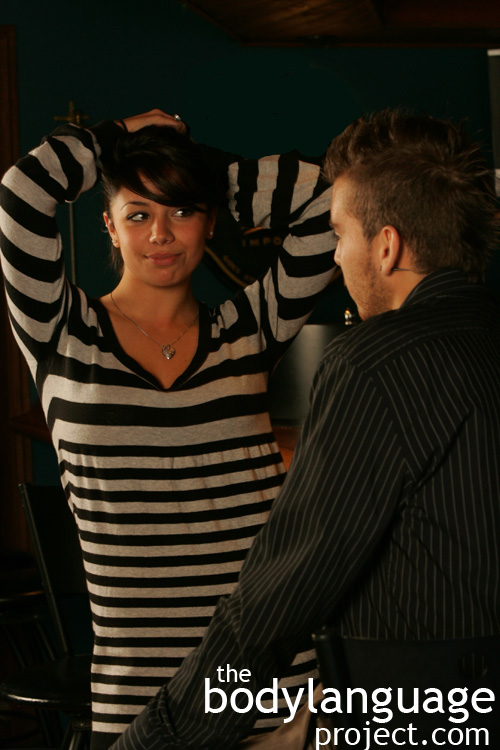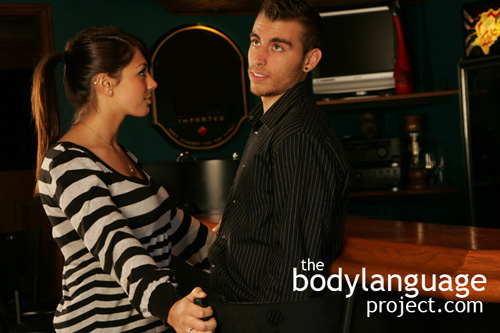Body Language of Voice Pitch
Synonym(s): N/A
Description: Pitch is a voice quality describing the number of vibrations emitted from the vocal cords in a unit of time. We detect pitch is the highness or lowness of the voice.
In One Sentence: The depth of the voice indicates dominance and submissiveness.
How To Use it: To appear more dominant lower the voice, to appear more submissive, raise the pitch of the voice. Both voice pitches, high and low, have a place for both men and women.
Men and women should lower their voice pitch when trying to appear in control, assertive and dominant. This will work in any context, but is especially crucial when leadership is required. While a high pitched female voice can be used to create obedience and fear, it will most likely be attributed to loss of control. When voices become high pitched they come across as emotional and this is then ascribed to the person. Lowering the voice, on the other hand, signals dominance which is a more natural way to create obedience.
In dating, men with deep voices are seen as more attractive as it signals higher dominance. Therefore, men should deepen their voices in a dating context. Research has also found that women can artificially make their voices sexier by deepening them. In fact, women were much better at making their voices sexy than men.
Conversely, when men and women wish to create a caring impression, they should use a higher pitched voice. A high pitched voice is best used with babies and small children. The aim is to mirror their voice pitch so as to create a likeness. This will facilitate trust.
Context: General.
Verbal Translation: “My voice is either highly pitched or deeply pitched and this depends on my level of dominance and authority and provides you with cues to how you should treat me and with how much respect I deserve.”
Variant: See Becoming Loud, Becoming Quiet or Whispering.
Cue In Action: Mom’s voice was soothing and calming, but when it came to getting her child to listen, she could raise her voice to a screech. Dad’s voice, on the other hand, was baritone. His voice boomed and put his little boy into action. When Dad talked, the 4-year-old knew the games were over and it was time for bed. His low deep voice resonated with dominance, striking fear in him.
Meaning and/or Motivation: The rate of vibration is controlled by the length and thickness of the vocal cords as well as how they are contracted or relaxed. The greater the vibrations, the higher the pitch, and therefore the higher the note achieved. In most cases, men’s voices are of lower pitch than women’s, but even men can tighten their vocal cords enough to achieve comparable pitch. Therefore, voice pitch is partly under conscious control. The highness and lowness of natural voices is affected by the body chemical androgen, which is the male sex hormone. The same hormone is tied to physical prowess and aggressiveness and also loosely tied to a competitor’s health and vigor making a low voice attractive to females when it is found in men.
To the nonverbal world, meaning is conveyed through pitch. When emotions run high, the voice can raise. A high voice pitch with a high volume is a scream which indicates heightened emotion such as anger, frustration, fear or excitement. A low voice has the reverse effect. It is often calming and authoritarian. Pitch also tells us what kind of person we are dealing with, be they subordinate with a higher pitch or dominant with lower pitch.
While we are all born with a certain natural voice pitch, it is possible to raise or lower our pitch to yield desired results. A woman may raise her voice pitch to gain favour from others, or she may lower it to command respect from colleagues. Generally, a high pitch tells others that we are ineffectual no matter how capable the person might really be. A low pitch with no inflection, showing no emotion, can also signal depression and weariness.
Cue Cluster: This cue coupled with other cues, can strengthen its meaning. A dominant voice with dominant body language increases the chances that a person is perceived that way. However, you might imagine a burley man with a weak, high pitched voice. This will likely confuse the body language reader as it is a mixed message. Voice pitch is just one cue so it must be read alongside other cues in the cluster.
Body Language Category: Amplifier, Authoritative body language, Audible signals, Submissive body language.
Resources:
Apicella C. L.; D. R. Feinberg and F. W. Marlowe. Voice Pitch Predicts Reproductive Success in Male Hunter-Gatherers. Biology Letters. 2007. 3:682–684. doi:10.1098/rsbl.2007.0410
http://bodylanguageproject.com/articles/hes-got-deep-voice-larger-family-tree-voice-pitch-predictor-reproductive-success-men/
Apicella, Coren L. and David R. Feinberg. Voice Pitch Alters Mate-Choice-Relevant Perception in Hunter–Gatherers. Proc. R. Soc. B. 2009. 276: 1077–1082
doi:10.1098/rspb.2008.1542
http://bodylanguageproject.com/articles/impress-higher-pitched-voice/
Abitbol, J., Abitbol, P., & Abitbol, B. (1999). Sex hormones and the female voice. Journal of Voice, 13, 424–446.
Bachorowski, J., & Owren, M. J. (1995). Vocal expression of emotion: Acoustic properties of speech are associated with emotional intensity and context. Psychological Science, 6, 219–224.
Brück, Carolin ; Kreifelts, Benjamin ; Wildgruber, Dirk. Emotional voices in context: A neurobiological model of multimodal affective information processing. Physics of Life Reviews. 2011 8(4): 383-403.
Cartei, Valentina and David Reby. Acting Gay: Male Actors Shift the Frequency Components of Their Voices Towards Female Values When Playing Homosexual Characters. Journal of Nonverbal Behavior. 2012. 36:79–93
DOI 10.1007/s10919-011-0123-4
http://bodylanguageproject.com/articles/purposely-gay-voice-pitch-male-actors-use-effeminate-voices-feign-homosexuality/
Fraccaro, Paul J.; Benedict C. Jones; Jovana Vukovic; Finlay G. Smith; Christopher D. Watkins; David R. Feinberg; Anthony C. Little and Lisa M. Debruine. Experimental Evidence That Women Speak in a Higher Voice Pitch to Men They Find Attractive. Journal of Evolutionary Psychology. 2011. 9(1): 57-67.
http://bodylanguageproject.com/articles/women-raise-voice-pitch-men-find-attractive/
Fraccaro, Paul J.; Jillian J. M. O’Connor; Daniel E. Re; Benedict C. Jones; Lisa M. DeBruine and David R. Feinberg. Faking it: Deliberately Altered Voice Pitch and Vocal Attractiveness. Animal Behaviour. 2013. 85: 127e136.
http://bodylanguageproject.com/articles/sound-little-atypical-measuring-artificial-lowering-raising-voice-pitch-men-women/
Gobl C, Nı´ Chasaide A (2003) The role of voice quality in communicating emotion, mood and attitude. Speech Commun 40: 189–212. doi: 10.1016/ S0167-6393(02)00082-1.
Hughes, S. M., & Gallup Jr., G. G. (2003). Sex differences in morphological predictors of sexual behavior: shoulder to hip and waist to hip ratios. Evolution and Human Behavior, 24, 173–178.
Hughes, S. M., Harrison, M. A., & Gallup Jr., G. G. (2002). The sound of symmetry: voice as a marker of developmental instability. Evolution and Human Behavior, 23, 173–180.
Hughes, Susan M.; Franco Dispenza and Gordon G. Gallup Jr.. Ratings of voice attractiveness predict sexual behavior and body configuration. Evolution and Human Behavior. 2004; 25: 295–304.
http://bodylanguageproject.com/articles/sexy-voices-linked-to-sexy-bodies-and-sexual-success/
Hughes, Susan M.; Franco Dispenza and Gordon G. Gallup Jr.. Ratings of voice attractiveness predict sexual behavior and body configuration. Evolution and Human Behavior. 2004; 25: 295–304.
http://bodylanguageproject.com/articles/sexy-voices-linked-sexy-bodies-sexual-success/
Hughes, S. M., & Gallup Jr., G. G. (2003). Sex differences in morphological predictors of sexual behavior: shoulder to hip and waist to hip ratios. Evolution and Human Behavior, 24, 173–178.
Hughes, S. M., Harrison, M. A., & Gallup Jr., G. G. (2002). The sound of symmetry: voice as a marker of developmental instability. Evolution and Human Behavior, 23, 173–180.
Herold, Debora S. ; Nygaard, Lynne C. ; Namy, Laura L. Say It like You Mean It: Mothers’ Use of Prosody to Convey Word Meaning. Language and Speech. 2012. 55(3): 423-436.
Krauss, R. M., Freyberg, R., & Morsella, E. (2002). Inferring speakers’ physical attributes from their voices. Journal of Experimental Social Psychology, 38, 618–625.
Lass, N. J., & Colt, E. G. (1980). A comparative study of the effect of visual and auditory cues on speaker height and weight identification. Journal of Phonetics, 8, 277–285.
Lass, N. J., & Davis, M. (1976). An investigation of speaker height and weight identification. Journal of the Acoustical Society of America, 60, 700–704.
Leongómez, Juan David; Jakub Binter; Lydie Kubicová; Petra Stolarová; Katerina Klapilová and Jan Havlícek, S. Craig Roberts. Vocal Modulation During Courtship Increases Proceptivity Even in Naive Listeners. Evolution and Human Behavior. 2014. doi: 10.1016/j.evolhumbehav.2014.06.008.
http://bodylanguageproject.com/articles/voice-pitching-courtship-competition/
Lass, N. J., & Colt, E. G. (1980). A comparative study of the effect of visual and auditory cues on speaker height and weight identification. Journal of Phonetics, 8, 277–285.
Lass, N. J., & Davis, M. (1976). An investigation of speaker height and weight identification. Journal of the Acoustical Society of America, 60, 700–704.
Laukkanen A-M, Vilkman E, Alku P, Oksanen H (1997) On the perception of emotions in speech: The role of voice quality. Logoped Phoniatr Vocol 22: 157– 168. doi: 10.3109/14015439709075330.
Mikach, S. M., & Bailey, M. (1999). What distinguishes women with unusually high numbers of sex partners? Evolution and Human Behavior, 20, 141–150.
Mikach, S. M., & Bailey, M. (1999). What distinguishes women with unusually high numbers of sex partners? Evolution and Human Behavior, 20, 141–150.
Nygaard, L. C., & Queen, J. S. (2008). Communicating emotion: Linking affective prosody and word meaning. Journal of Experimental Psychology: Human Perception and Performance, 34, 1017–1030.
Puts, David A.; Julia L. Barnd; Lisa L.M.; Welling, Khytam Dawood; and Robert P. Burriss. Intrasexual Competition Among Women: Vocal Femininity Affects Perceptions of Attractiveness And Flirtatiousness. Personality and Individual Differences. 2011; 50: 111-115.
http://bodylanguageproject.com/articles/women-use-voice-pitch-flirt-compete-men
Puts, David A.; Coren L. Apicella and Rodrigo A. Cárdenas. Masculine Voices Signal Men’s Threat Potential in Forager and Industrial Societies. Proceedings of the Royal Society. 2011. doi: 10.1098/rspb.2011.0829
http://bodylanguageproject.com/articles/deep-voice-signals-potential-threat-use-body-language-dominance/
Scherer KR (2003) Vocal communication of emotion: A review of research paradigms. Speech Commun 40: 227–256. doi: 10.1016/S0167-6393(02)00084-5.
Sally D. Farley, Susan M. Hughes, Jack N. LaFayette. People Will Know We Are in Love: Evidence of Differences Between Vocal Samples Directed Toward Lovers and Friends. Journal of Nonverbal Behavior, 2013; 37 (3): 123.
http://bodylanguageproject.com/articles/are-they-cheating-research-says-voice-may-betray-them/
Susan Hughes, Justin Mogilski, Marissa Harrison. The Perception and Parameters of Intentional Voice Manipulation. Journal of Nonverbal Behavior, 2014 DOI: 10.1007/s10919-013-0163
http://bodylanguageproject.com/articles/her-voice-is-hot-his-is-not/
Sturman, Edward D. Invluntary Subordination and Its Relation to Personality, Mood,
and Submissive Behavior. Psychological Assessment. 2011. 23(1): 262-276 DOI: 10.1037/a0021499
http://bodylanguageproject.com/articles/nonverbal-submission-men-women-depression-critical-examination-use-disuse-submission/
Sturman, Edward D. Invluntary Subordination and Its Relation to Personality, Mood,
and Submissive Behavior. Psychological Assessment. 2011. 23(1): 262-276 DOI: 10.1037/a0021499
http://bodylanguageproject.com/articles/nonverbal-submission-men-women-depression-critical-examination-use-disuse-submission/
Sei Jin Ko; Melody S. Sadler and Adam D. Galinsky. The Sound of Power Conveying and Detecting Hierarchical Rank Through Voice. Psychological Science. 2014. DOI: 956797614553009
http://bodylanguageproject.com/articles/power-produces-dominance-voice-study/
Scherer, K., Banse, R., Wallbott, H., & Goldbeck, T. (1991). Vocal cues in emotion encoding and decoding. Motivation and Emotion, 15, 123–148.
Singh, L., Morgan, J. L., & Best, C. T. (2002). Infants’ listening preferences: Baby talk or happy talk? Infancy, 3, 365–394.
Scherer, Klaus R. Personality inference from voice quality: The loud voice of extroversion. European Journal of Social Psychology. 1978 8(4): 467-487.
Trainor, L. J., Austin, C. M., & Desjardins, R. N. (2000). Is infant-directed speech prosody a result of the vocal expression of
emotion? Psychological Science, 11, 188–195.
Siegman, Aron Wolfe ; Boyle and Stephen Mineka. Voices of Fear and Anxiety and Sadness and Depression: The Effects of Speech Rate and Loudness on Fear and Anxiety and Sadness and Depression. Journal of Abnormal Psychology. 1993. 102(3): 430-437.
Walker-Andrews, A., & Grolnick, W. (1983). Discrimination of vocal expressions by young infants. Infant Behavior and Development, 6, 491–498.
Zuckerman, M., & Driver, R. (1989). What sounds beautiful is good: the vocal attractiveness stereotype. Journal of Nonverbal Behavior, 13, 67–82.














